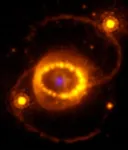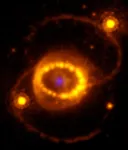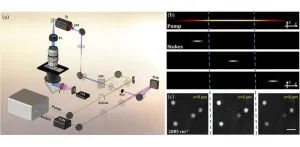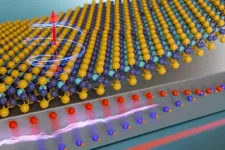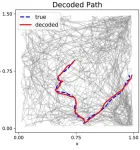(Press-News.org) New Haven, Conn. — Nearly 30 years ago, scientists discovered a unique class of anticancer molecules in a family of bryozoans, a phylum of marine invertebrates found in tropical waters.
The chemical structures of these molecules, which consist of a dense, highly complex knot of oxidized rings and nitrogen atoms, has attracted the interest of organic chemists worldwide, who aimed to recreate these structures from scratch in the laboratory. However, despite considerable effort, it has remained an elusive task. Until now, that is.
A team of Yale chemists, writing in the journal Science, has succeeded in synthesizing eight of the compounds for the first time using an approach that combines inventive chemical strategy with the latest technology in small molecule structure determination.
“These molecules have been an outstanding challenge in the field of synthetic chemistry,” said Seth Herzon, the Milton Harris ’29 Ph.D. Professor of Chemistry in Yale’s Faculty of Arts and Sciences and corresponding author of the new study. “A number of research groups have tried to recreate these molecules in the lab, but their structures are so dense, so intricately connected, that it hasn’t been possible. I’ve been reading about efforts to synthesize these compounds since I was a graduate student in the early 2000s.”
In nature, the molecules are found in some species of bryozoa — small, aquatic animals that feed by filtering prey from the water via tiny tentacles. Researchers worldwide consider bryozoans to be a potentially valuable source of new medications, and many molecules isolated from bryozoans have been studied as novel anticancer agents. However, the complexity of the molecules often limits their further development.
Herzon’s team looked at a particular species of bryozoa called Securiflustra securifrons.
“We worked on these molecules about a decade ago, and though we were not successful in recreating them at that time, we gleaned insight into their structure and chemical reactivity, which informed our thinking,” Herzon said.
The new approach involved three key strategic elements. First, Herzon and his team avoided constructing a reactive heterocyclic ring, known as an indole, until the end of the process. A heterocyclic ring contains two or more elements — and this specific ring is known to be reactive and create problems, Herzon said.
Second, the researchers used methods known as oxidative photocyclizations to construct some of the key bonds in the molecules. One of these photocyclizations involved the reaction of a heterocycle with molecular oxygen, which was first studied by Yale’s Harry Wasserman in the 1960s.
Lastly, Herzon and his team employed microcrystal electron diffraction (MicroED) analysis to help visualize the structure of the molecules. Herzon said conventional methods for structure determination were inadequate in this context.
The result of the new approach is eight new synthetic molecules with therapeutic potential — and the promise of more new chemistry to come.
“These molecules hit right at my love of complex synthetic challenges,” said Herzon, who is also a member of the Yale Cancer Center and holds joint appointments in pharmacology and therapeutic radiology at Yale School of Medicine. “On a molecular weight basis, they are modest relative to other molecules we’ve studied in my lab. But from the vantage point of chemical reactivity, they present some of the greatest challenges we’ve ever taken on.”
Co-first authors of the new study are Yale chemistry graduate students Brandon Alexander and Noah Bartfield. Co-authors are Vaani Gupta, a Yale chemistry graduate student; Brandon Mercado, a Yale X-ray crystallographer and lecturer in the Department of Chemistry; and Mark Del Campo of Rigaku Americas Corporation.
The National Science Foundation helped fund the research.
END
Yale chemists synthesize unique anticancer molecules using novel approach
2024-02-22
ELSE PRESS RELEASES FROM THIS DATE:
Maynooth University partners in study published in Science that finds evidence of elusive neutron star
2024-02-22
A new study, published in Science and co-authored by Dr Patrick Kavanagh of Maynooth University’s Department of Experimental Physics in Ireland, has provided the first conclusive evidence for the presence of the elusive neutron star produced in the supernova SN 1987A.
Supernovae are the spectacular end result of the collapse of stars more massive than eight to ten times the mass of the sun. Besides being the main sources of chemical elements such as the carbon, oxygen, silicon, and iron that make life possible, they are also responsible for creating the ...
James Webb telescope detects traces of neutron star in iconic supernova
2024-02-22
Scientists can finally show that a neutron star formed from our most well-studied supernova, SN 1987A. The breakthrough was made possible thanks to the James Webb telescope.
Supernovae are the spectacular end result of the collapse of stars more massive than 8-10 times the mass of the sun. Besides being the main sources of chemical elements such as carbon, oxygen, silicon, and iron that make life possible, they are also responsible for creating the most exotic objects in the universe, neutron stars and black holes.
In 1987, supernova 1987A (SN 1987A) ...
Enhanced 3D chemical imaging with phase-modulation
2024-02-22
Understanding complex biological and biomedical systems is greatly aided by 3D imaging, which provides much more detailed information than traditional two-dimensional methods. However, live cell and tissue imaging remain challenging due to factors like limited imaging speed and significant scattering in turbid environments.
In this context, multimodal microscopy techniques are notable. Specifically, nonlinear techniques like CRS (coherent Raman scattering) use optical vibrational spectroscopy, providing precise chemical imaging in tissues and cells in a label-free way. Furthermore, stimulated Raman scattering (SRS) ...
Researchers harness 2D magnetic materials for energy-efficient computing
2024-02-22
CAMBRIDGE, MA — Experimental computer memories and processors built from magnetic materials use far less energy than traditional silicon-based devices. Two-dimensional magnetic materials, composed of layers that are only a few atoms thick, have incredible properties that could allow magnetic-based devices to achieve unprecedented speed, efficiency, and scalability.
While many hurdles must be overcome until these so-called van der Waals magnetic materials can be integrated into functioning computers, MIT researchers took an important step in this direction by demonstrating precise control of a van der ...
Empowering autistic teens: New clinician advice for navigating chronic pain
2024-02-22
When you’re an autistic teenager living with chronic pain, getting treatment for your pain can be a challenging experience. That’s according to a group of young people who’ve spoken to Dr. Abbie Jordan of the Department of Psychology and Centre for Pain Research at The University of Bath about their experiences. Teenagers mention sensory issues, a lack of autism awareness among staff, or feeling “doubly different” compared to their peers, making receiving “one-size-fits-all” psychologically focused treatment for their chronic pain ...
Climate change linked to rise in mental distress among teens, according to Drexel study
2024-02-22
Worsening human-induced climate change may have effects beyond the widely reported rising sea levels, higher temperatures, and impacts on food supply and migration – and may also extend to influencing mental distress among high schoolers in the United States.
According to a representative survey of 38,616 high school students from 22 public school districts in 14 U.S. states, the quarter of those adolescents who had experienced the highest number of days in a climate disaster within the past two years and the past five years – such as hurricanes, floods, tornadoes, droughts, and wildfire – had 20% higher odds of developing mental ...
Combination of group competition and repeated interactions promotes cooperation
2024-02-22
One of the great unresolved mysteries of human evolution is how pro-social, cooperative behavior could have evolved. What led to the establishment of a behavior that prioritizes the benefit of the community over that of the individual in a world where materially successful individuals reproduce, and others slowly perish?
The prevailing theory suggests that this occurred due to repeated interactions. Over generations, humans learned that cooperative behavior pays off in the long run. People collaborate because they anticipate interacting with the same individuals ...
A new beginning: The search for more temperate Tatooines
2024-02-22
New Haven, Conn. — Luke Skywalker’s childhood might have been slightly less harsh if he’d grown up on a more temperate Tatooine — like the ones identified in a new, Yale-led study.
According to the study’s authors, there are more climate-friendly planets in binary star systems — in other words, those with two suns — than previously known. And, they say, it may be a sign that, at least in some ways, the universe leans in the direction of orderly alignment rather than chaotic misalignment.
For the study, ...
Moffitt study highlights urgent need to address impact of extreme weather events on cancer survivorship
2024-02-22
TAMPA, Fla. — Hurricanes and other extreme weather events pose immediate threats to life and property and have long-lasting impacts on health outcomes, particularly for cancer survivors. In a mini-review published today in Cancer Epidemiology, Biomarkers & Prevention, a journal from the American Association for Cancer Research, Moffitt Cancer Center researchers shed light on the significant gaps in understanding and addressing the effects of hurricanes and extreme weather events on biological, psychosocial and clinical outcomes among cancer survivors.
Researchers ...
Scientists can tell where a mouse is looking and located based on its neural activity
2024-02-22
Researchers have paired a deep learning model with experimental data to “decode” mouse neural activity. Using the method, they can accurately determine where a mouse is located within an open environment and which direction it is facing just by looking at its neural firing patterns. Being able to decode neural activity could provide insight into the function and behavior of individual neurons or even entire brain regions. These findings, publishing February 22 in Biophysical Journal, could also inform the design of intelligent machines that currently ...
